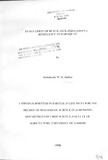| dc.description.abstract | Two experiments were conducted to study resistance of Bidens. pilosa to paraquat. A
resistant and susceptible biotypes of the weed were used. The first experiment looked at the
effect of paraquat application rate on control of the B. pilosa biotypes at different stages of
growth. Paraquat (Gramoxone 20%) was applied at rates of 1,3,5,7, and 9 litres per
hectare. The growth stages comprised 2, 4, 6 and 8 weeks after emergence. Assessments of
the survival rate were done at three and twenty one days after each herbicide application
episode. Results showed that the injurious effects of the herbicide increased with increasing
application rate. Conversely, E. pilosa resistance to the herbicide increased with delayed
application so that application of the herbicide in late phenological stages effected less
control than early application. In all application rates and growth stage, the herbicide had
less effect on the resistant biotype than the susceptible one.
The second experiment examined the relative growth fitness of the two biotypes in a
replacement series experiment. The two biotypes were grown together in different planting
ratios of the 75% Bl : 25% B2, 50% Bl : 50% B2, 25% Bl : 75% B2. Plant height, leaf
area and number of leaves were determined three weeks after emergence and at flowering.
In addition, number of inflorescence, fresh weight and dry weight were measured at
flowering.
B 1 plants out-fitted B2 plants in the early stage of the growth in terms of plant height
and number of leaves. At flowering stage B 1 plants produced larger number of branches
than B2 plants and consequently produced larger number of inflorescences.
It is suggested that plants population dynamics would favour the susceptible biotype
over the resistant one if no herbicide is used. On the other hand, use of the herbicide which
controls the susceptible biotype would favour dominance by the resistant one. | en |

